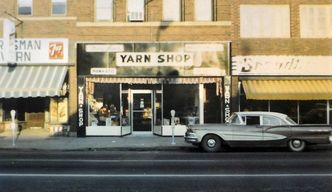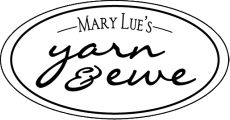Yarn shop spans 50 years By Tim Krohn tkrohn@mankatofreepress.com | Posted: Sunday, January 25, 2015 10:13 pm

This shop on Front Street in Mankato in the 1960s was one of a few satellite stores operated by Mary Lue's Yarn.
MANKATO — Peggy Grey has seen many trends come and go as she grew up working in her family's St. Peter Woolen Mill and Mary Lue's Yarn & Ewe shops.
"Now it's wrist knitting," said Grey, who owns Mary Lue's in Old Town Mankato.
Wrist knitting is pretty much what it sounds like. "You loop the yarn around your wrists and knit rather than using needles."
Since her mom, Mary Lue Brinker, opened a yarn shop in 1965 in St. Peter, Grey has catered to knitters with a wide variety of yarn and supplies.
While wool and natural fibers are still a mainstay of making yarn, a host of exotic materials are used. "Now they can make it from all sorts of things — sugar cane yarn, bamboo, soy yarn."
Now celebrating her store's 50th year in business, Grey is working out of a space that was part of the former Harpies' Bazaar in Old Town. She relocated there from St. Peter in 2007.
The shop is tied to a long and rich history that began with the St. Peter Woolen Mill, which started in St. Peter in 1867 and remains there today.
In 1912, John Charles Brinker and Margaret Brinker bought the woolen mill. Their son Charles Eugene Brinker and his wife, Mary Lue, later purchased it. Their daughters, Grey and Pat Johnson, and a son grew up in the business.
Today, Grey runs the yarn shop while Johnson runs the mill.
Grey's parents also ran a hatchery business in part of the large three-story building that housed the woolen mill. When they closed the hatchery, Mary Lue opened a yarn shop. "Mom decided there was a need because there wasn't a lot of good yarn. We weren't making yarn (in the mill) but it tied to the mill," Grey said.
The 1998 tornadoes ripped a floor-and-a-half off of the woolen mill. "Our parents were still involved then and they asked what we wanted to do, if we wanted to continue or give up and do something else," Grey said. "It was our livelihood for a long time and we wanted to continue."
The sisters decided to move forward with the mill renovated to a smaller size.
The St. Peter mill still does a lot of custom wool processing, taking in people's raw wool, processing it and returning the same wool to them. Many of the remaining mills take wool in and co-mingle it with wool from others. "A lot of people are sentimental about where their wool comes from."
Grey said there are only a handful of independent yarn shops in southern Minnesota.
"We do a lot of classes. I think more people are taking classes because they view it as a social activity and not just a learning activity.
"As a shop we strive to be kind of middle-of-the road in price point. But my philosophy is anyone should be able to afford to knit, so we carry low end and high end, too.
MANKATO — Peggy Grey has seen many trends come and go as she grew up working in her family's St. Peter Woolen Mill and Mary Lue's Yarn & Ewe shops.
"Now it's wrist knitting," said Grey, who owns Mary Lue's in Old Town Mankato.
Wrist knitting is pretty much what it sounds like. "You loop the yarn around your wrists and knit rather than using needles."
Since her mom, Mary Lue Brinker, opened a yarn shop in 1965 in St. Peter, Grey has catered to knitters with a wide variety of yarn and supplies.
While wool and natural fibers are still a mainstay of making yarn, a host of exotic materials are used. "Now they can make it from all sorts of things — sugar cane yarn, bamboo, soy yarn."
Now celebrating her store's 50th year in business, Grey is working out of a space that was part of the former Harpies' Bazaar in Old Town. She relocated there from St. Peter in 2007.
The shop is tied to a long and rich history that began with the St. Peter Woolen Mill, which started in St. Peter in 1867 and remains there today.
In 1912, John Charles Brinker and Margaret Brinker bought the woolen mill. Their son Charles Eugene Brinker and his wife, Mary Lue, later purchased it. Their daughters, Grey and Pat Johnson, and a son grew up in the business.
Today, Grey runs the yarn shop while Johnson runs the mill.
Grey's parents also ran a hatchery business in part of the large three-story building that housed the woolen mill. When they closed the hatchery, Mary Lue opened a yarn shop. "Mom decided there was a need because there wasn't a lot of good yarn. We weren't making yarn (in the mill) but it tied to the mill," Grey said.
The 1998 tornadoes ripped a floor-and-a-half off of the woolen mill. "Our parents were still involved then and they asked what we wanted to do, if we wanted to continue or give up and do something else," Grey said. "It was our livelihood for a long time and we wanted to continue."
The sisters decided to move forward with the mill renovated to a smaller size.
The St. Peter mill still does a lot of custom wool processing, taking in people's raw wool, processing it and returning the same wool to them. Many of the remaining mills take wool in and co-mingle it with wool from others. "A lot of people are sentimental about where their wool comes from."
Grey said there are only a handful of independent yarn shops in southern Minnesota.
"We do a lot of classes. I think more people are taking classes because they view it as a social activity and not just a learning activity.
"As a shop we strive to be kind of middle-of-the road in price point. But my philosophy is anyone should be able to afford to knit, so we carry low end and high end, too.

 RSS Feed
RSS Feed